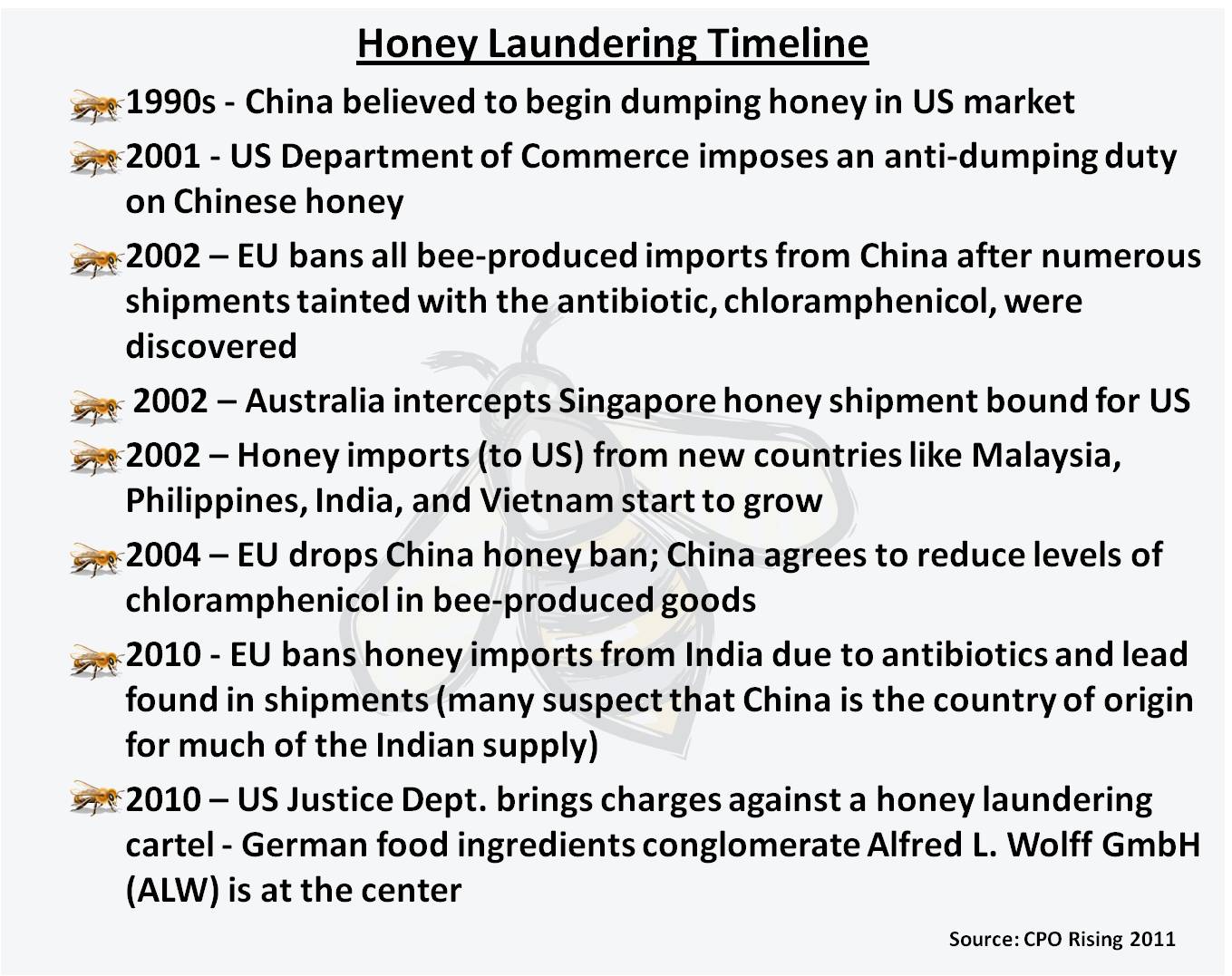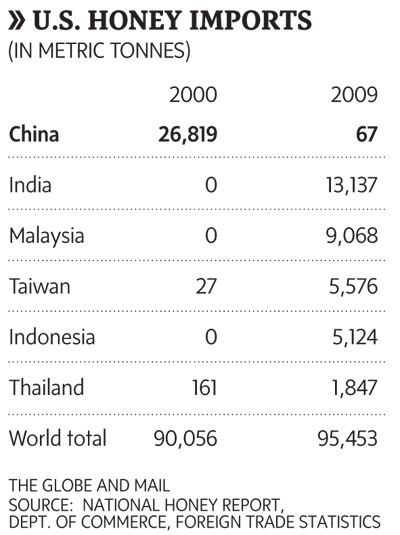On Monday, this small story (hat tip: Susan) that sits at the intersection of globalization, sourcing, international crime, corporate conspiracy, food supply, and supply risk captured my attention. The story claims that at least one-third of all honey consumed in the US is smuggled in from China illegally. The story also fingers India’s largest honey exporter of illegally “laundering” honey from China and directing it to US shores. Although this is just the latest report in a long series of reports over the past decade that have identified supply risk problems with honey originating in China, we believe that this story warrants greater coverage and that the sourcing and procurement pros dealing with this category should be aware of the issues. And, as a parent that had just served a breakfast of toast topped with fruit and honey to his daughter, we believe that this is a story worthy of our own research and analysis – which is what follows.
Sweet Treat, Sour History
Honey is, of course, the naturally-made sweet food produced by bees. While there are many different kinds of honey produced by many different types of bees. The honey that is consumed by humans is produced by honey bees and, according to Honey.com, 60,000 honey bees must fly a collective 55,000 miles and draw nectar from approximately 2 million flowers to create one pound of honey. The Food and Agriculture Organization of the United Nations reported that in 2005, China, Argentina, Turkey, and the US were the largest global producers of honey. Most countries in North America and Europe consume more honey than they produce. For example, the US, which is the largest honey consumer, uses about 400 million pounds of honey each year but produces less than half of its needs. Of that 400 million, it is estimated that 35% of the honey is sold to consumers while the other 65% is used as ingredients in other products. Below is a timeline highlighting the recent honey importing issues that we have drawn from a variety of sources:
 By many reports, lower-cost Chinese honey began flooding the markets in the 1990s. Beyond its labor advantages, research has shown that China’s cost advantage with honey stems from its practice of harvesting or tapping honey early, before it matures, resulting in more moisture in the contents and a poorer quality of honey. In response to complaints from US honey producers that China was dumping honey in the US, the US Department of Commerce imposed a strict tariff on Chinese honey in 2001. Over the next few years, the production of honey imported from China shrank dramatically. Over the same period, of time, honey imports from countries that had never sent honey to the US began to rise dramatically (see below).
By many reports, lower-cost Chinese honey began flooding the markets in the 1990s. Beyond its labor advantages, research has shown that China’s cost advantage with honey stems from its practice of harvesting or tapping honey early, before it matures, resulting in more moisture in the contents and a poorer quality of honey. In response to complaints from US honey producers that China was dumping honey in the US, the US Department of Commerce imposed a strict tariff on Chinese honey in 2001. Over the next few years, the production of honey imported from China shrank dramatically. Over the same period, of time, honey imports from countries that had never sent honey to the US began to rise dramatically (see below).
Honey Laundering
Shortly after the US began imposing duties on Chinese honey, Australia discovered and stopped a series of shipments of honey that were imported from Singapore (an island with no honey-production capabilities at the time) and headed to the US. The Australian investigation showed that the honey had originated in China and had been laundered (or re-routed) through Singapore. Over the next few years, there was a widely-held view in the industry that certain US importers of were guilty of “honey laundering” and knowingly re-routed Chinese-produced honey through other countries to avoid tariffs. These suspicions were validated last year when the US Justice Department indicted fifteen people and six companies spanning from Asia to Germany and the U.S. for their roles in a honey laundering scheme that avoided nearly $80 million in anti-dumping duties and knowingly placed honey that was tainted with dangerous antibiotics into the US food supply (this press release details the charges).
Yes, honey laundering is not just a free trade issue, it is one of supply risk and public safety; with roughly 73 million pounds of imported honey sold in grocery stores each year and another 135+ million pounds of imported honey used in other products, this issue has potentially huge ramifications.
The practices of those arrested in the honey cartel were deceitful, despicable and clearly unlawful and the US government should be commended for bringing forward these indictments. Unfortunately, according to many industry experts, the arrests have not been an effective deterrent to other laundering schemes and the US food supply continues to face serious potential risks from contaminated honey.
Contaminated Honey
Around the same time that the US levied trade duties on Chinese honey, the Chinese bee population was severely crippled by a “foulbrood” epidemic that killed millions of bees. To combat the disease, the Chinese used the antibiotic, chloramphenicol. They were successful in slowing the spread of disease, but as with the use of many drugs, some ‘side effects did occur.’ According to TheNibble.com’s discussion of Organic Honey, “chloramphenicol is a broad-spectrum antibiotic. It is not used in the U.S. in humans except in cases of desperation, where other antibiotics have failed. The FDA [US Food & Drug Administration] has a “zero tolerance” policy for the presence of this antibiotic in food because it is known to cause aplastic anemia, a sometimes-fatal disease which affects the ability of one’s bone marrow to produce red blood cells. Chloramphenicol is also a suspected carcinogen.” In case you were wondering, the FDA has a zero tolerance because the antibiotic can damage the DNA in children.
The EU found several batches of tainted honey and responded quickly by including bee-produced food as part of a much larger ban on Chinese food imports that began in 2002. The US did not adopt any such ban. The general EU ban (including honey) was subsequently relaxed two years later as part of a general easing on Chinese food imports due to improved confidence in the Chinese food supply chain.
That brings us to last June when the EU banned honey from India because it found at least two antibiotics and high traces of lead in almost a quarter of tested shipments. Compounding the issue was the fact that most of these honey importers/exporters were unable to provide any traceability evidence regarding the honey’s country of origin – they could not prove that the honey was produced in India (and not produced in China). While the FDA has made some recent announcements regarding new policies to improve food quality, as yet, the US has not adopted any such ban on Indian honey.
A Sticky Issue
What appears, at first pass, to be a very straightforward issue – how to stop illegal and/or tainted honey imports from entering the food chain – is actually very complex. For example, the EU and the US have chosen to pursue different strategies; at the same time, it is not clear that they share any information. There are many factors that must be addressed, including the ability and cost of tracking and testing (some of) the millions of pounds of honey that enter the different US and EU ports. No big answers today, but our reporting on this story will continue…
Tagged in: Globalization, Procurement Fraud, Sourcing, Suppliers, Supply Risk









